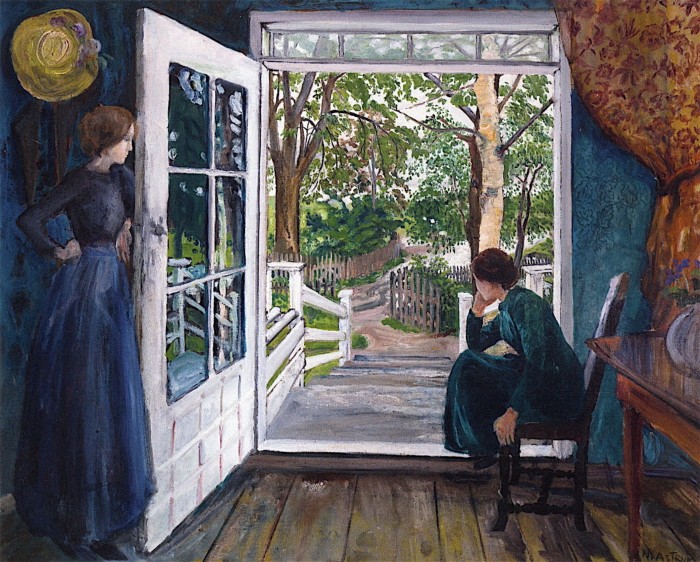When one door closes . . .

Stay informed with free updates
Simply sign up to the Life & Arts myFT Digest — delivered directly to your inbox.
The other day I was sitting in my living room preparing to call a friend I hadn’t seen in over a year. We’ve known one another for decades and, although we live in different countries with busy lives, we try to have these regular lengthy catch-ups every six weeks or so. I was alone in my apartment — but even so, I got up and shut the living-room door. I tend to do that before starting a meaningful conversation on the phone. I suppose it’s a way of trying to create a space in which to contain the energy of a conversation.
My friend, a doctor, had recently opened her own private practice and while this represented a major goal achieved, she was telling me on the call about dealing with the new sets of challenges it brought. I, in turn, shared with her a personal and professional decision I was trying to make. After the call, I started thinking about the closing and opening of doors and how often we use that language to contemplate events in our lives.
There’s something so stirring about Edward Hopper’s 1951 painting “Rooms by the Sea”. It was originally titled “The Jumping Off Place”, but Hopper noted that people thought that was too ominous a title, so he changed it. An apparently simple painting composed of sharp geometric shapes, it depicts two rooms divided by a large white wall, and a doorway to the right that leads straight to the ocean. Behind the white wall we see parts of a living room: the end of a couch, the edge of a cabinet, a glimpse of a painting on the wall and a green carpet. I particularly like how Hopper paints the perspective as though we are the ones in the room facing the sea. All we see through the door is blue sky above and deep blue water below. Sunlight pours into the room through this doorway.
I’m struck by this work because it immediately makes me think about the complex situation when a door unexpectedly opens in our lives and seems to beckon us into the unimaginable. I have, many times, felt like I was standing in front of this doorway, enticed by the vibrancy of what lay beyond the comfort of my familiar surroundings. Often these were occasions when I felt compelled to follow an inner compass that required me to leave a place that felt secure.
A few years after graduate school, for example, I was settled in an engaging job working with students and running a small department at a university. The role came with many of the trappings of security but something felt deeply lacking to me. At the time, I was keen to get a writing career off the ground. But it took me a couple of years before I risked leaving the safety net of what was comfortable and predictable and walked through the doorway of the unknown.
Hopper’s painting makes me think more expansively about what lies beyond what we can see. The ocean is deep and unknown — and without the right equipment, we would not survive in it for long — but it is also a thriving world of its own, full of life. Stepping through the door in the painting without the right preparation or forethought would be foolish. But it doesn’t mean we shouldn’t take that risk.
“By the Open Door” is an early 20th-century work by Norwegian artist Nikolai Astrup. In this painting we see two women positioned very differently in a doorway. The figure on the left stands with one hand on her hip and the other supporting her as she leans on the edge of the door. Her gaze seems to rest on the other woman, who sits perched on a chair, either expectantly or wistfully, with her feet resting on the door ledge so that a part of her body is slightly outside. She is staring towards a winding garden path that leads from the house into the street.

It’s natural to assume that this is a painting of women awaiting someone’s arrival. But I see something different. I think of the many ways women have historically been defined by domesticity and regulated by the boundaries of such spaces, whether they wanted to be or not. So I imagine the body language of the standing woman towards the seated woman is one of curious impatience, as if she is asking: “So are you going to just sit there all day or actually do something about your situation and whatever it is you’re thinking?”
This interpretation leads us to a further question: when have we found ourselves waiting for permission from someone else to venture where others might not imagine we belong, or to do what others may not consider us capable of? Who do we allow to decide where the boundaries fall for us, and what doors we are permitted or encouraged to walk through? It’s poignant to me that the door in Astrup’s painting is wide open and that both women appear to be on the verge of stepping out. Sometimes I wonder if we prevent ourselves from seizing these sorts of opportunities.
Dorothea Tanning was a Surrealist artist who used doors as a recurring motif in her work. I find her 1943 painting “Eine Kleine Nachtmusik” compelling because it invites us to consider the doors that stand at the threshold to our interior worlds. In this painting two young girls, or dolls, stand in a long red-carpeted corridor with four numbered doors against the wall. All the doors are closed — except for the last one, which is slightly ajar, and through which a sliver of light is visible. One of the girls rests against the first door, dressed in a white tattered skirt, white tights and shoes, her red shirt open to expose her upper body. In her hand she clutches the oversized petals of a sunflower. The other girl, also in tattered clothes stands in the middle of the hallway, hair raised on end. There is a monstrously sized sunflower on the carpet that looks as though it has been wrestled to the ground.

Whatever dimension this scene is meant to represent, both the girls look like they have been through something not just exhausting but life-altering. It makes me think about the interior battles we may sometimes have to confront in order to find a door that leads to the next stage of our lives.
I wonder how much we consider that some doors may only open for us when we have done a particular kind of interior work, the task of facing our fears or reckoning with necessary feelings, or even past experiences. Like the figures in Tanning’s painting, we will come across many doors in our lives; knowing which to open and walk through and which to leave closed is the ongoing challenge for us all.
Email Enuma at [email protected]
Find out about our latest stories first — follow FT Weekend on Instagram and X, and subscribe to our podcast Life & Art wherever you listen
#door #closes




